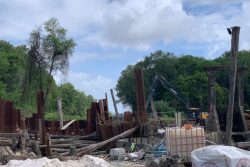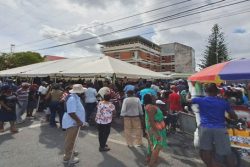Local drug traffickers’ moves to put cocaine in everything they possibly could to get it out of the country to where it can earn big bucks in North America resulted in a tragic occurrence last week when four people died, including a child, after drinking what was suspected to be SSS Tonic laced with liquid cocaine.
A fifth individual, another child was hospitalized for a short period. It was reported that having tasted the liquid, he spat it out and then drank juice to get the taste out of his mouth. To date, the police have been unable to find the man who took the SSS Tonic to the East La Penitence home of former soldier Alex Blair, 40, and his hairdresser wife Simone Price, 36. They died, along with their 6-year-old son Jahaquel Blair and their friend Natasha George, 36. But even if that person were found, could he be charged with any offence? Was it not naiveté that saw them ingesting the liquid when they were not sure of how or where it might have been procured? What if the person who delivered it had received it from a third party?
The age-old practice of taking care parcels from persons in Guyana to their relatives and friends overseas had long become one that was treated with some amount of wariness. The deaths of the Blairs, Price and George will no doubt push it to extinction.
The tragically horrific incident brings to the fore again the lengths to which drug dealers are prepared to go to facilitate their trade.
Cocaine, in various forms has been placed in food items, alcohol, fruit, sweets, wood, wigs, body orifices and ingested as pellets enclosed in plastic. It has also been placed into the suitcases of unknowing persons.
Putting cocaine in SSS Tonic was novel, but it should have been suspect since SSS Tonic is manufactured in the US and available for sale there. And even if it weren’t, taking a multivitamin and iron supplement to the US where so many are being produced every day would be akin to taking coals to Newcastle. The issue of trust should have been foremost in the minds of Blair and Price, since the person who was intended to take the tonic left it behind along with other items that can regularly be found in the suitcases of Guyanese travelling to the US, Canada and the UK.
Cocaine is a huge industry here and even with all of the seizures made over the years, local law enforcement is still unable to make enough headway in clamping down on it.
It is well known that Guyana is a transshipment point and not an origin country for cocaine. It has to be smuggled in to Guyana, before it can be handed to the mules earmarked to take it out. So where are the seizures of the incoming shipments? Why aren’t there instances of the Police Narcotics Branch or the Customs Anti-Narcotic Unit swooping down on cocaine imports? Surely, if it doesn’t come in it cannot go out.
From the quantities being exported, it is clear that huge amounts are being imported. The bales that were dropped at Loo Lands, Demerara River in 1993 by a low flying aircraft, for instance, pointed to this being the case, but the authorities failed to capitalize on that. Further, since then, there have been discoveries of at least two illegal airstrips in the country’s interior. In addition, between 1998 and 2007, at least three aircraft were found in interior locations and all three had been burned. There was no indication that they had crashed, but they might have experienced some mechanical or other failure which would have prevented them from being flown out of the country again with the same amount of stealth with which they entered. The small planes had been landed and then burned. They were suspected to have brought cocaine into Guyana for reshipment, but of course, by the time they were found, there was no trace of their pilots or cargo.
The magnitude of the gains from this trade is indicated when destroying aircraft worth upwards of US$500,000 is an option and when, regardless of the dangers involved, there continues to be takers on the wholesale, retail and distribution ends of it.
While the police force is not equipped to conduct any surveillance of Guyana’s airspace, surely it can make inroads into the cocaine factories. Large quantities of illegal drugs must be taken somewhere to be parceled out, liquefied or otherwise transformed for the reshipment process and for retail sale as well. In a majority of the successful cocaine busts made here, the police and CANU are detailed as having ‘acted on information’. All police forces have their networks of informants, local investigators must also try to cultivate those who can provide information on the other side of the trade.




